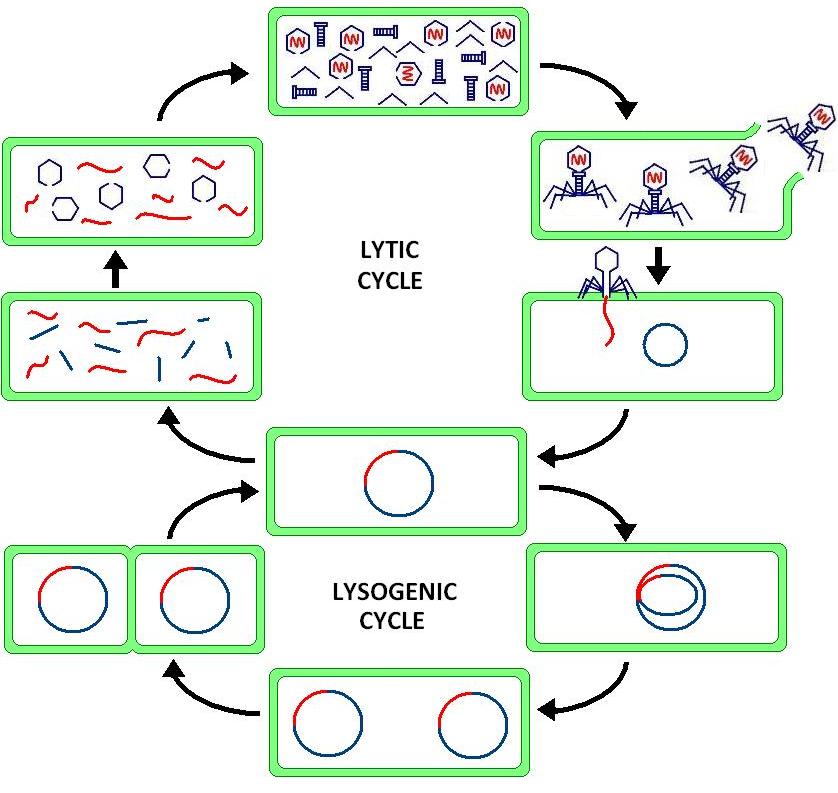Temperate Phage on:
[Wikipedia]
[Google]
[Amazon]
In

virology
Virology is the Scientific method, scientific study of biological viruses. It is a subfield of microbiology that focuses on their detection, structure, classification and evolution, their methods of infection and exploitation of host (biology), ...
, temperate refers to the ability of some bacteriophages
A bacteriophage (), also known informally as a phage (), is a virus that infects and replicates within bacteria. The term is derived . Bacteriophages are composed of proteins that encapsulate a DNA or RNA genome, and may have structures tha ...
(notably coliphage λ) to display a lysogenic life cycle. Many (but not all) temperate phages can integrate their genome
A genome is all the genetic information of an organism. It consists of nucleotide sequences of DNA (or RNA in RNA viruses). The nuclear genome includes protein-coding genes and non-coding genes, other functional regions of the genome such as ...
s into their host bacterium's chromosome, together becoming a lysogen as the phage genome becomes a prophage
A prophage is a bacteriophage (often shortened to "phage") genome that is integrated into the circular bacterial chromosome or exists as an extrachromosomal plasmid within the bacterial cell (biology), cell. Integration of prophages into the bacte ...
. A temperate phage is also able to undergo a productive, typically lytic
The lytic cycle ( ) is one of the two cycles of viral reproduction (referring to bacterial viruses or bacteriophages), the other being the lysogenic cycle. The lytic cycle results in the destruction of the infected cell and its membrane. Bact ...
life cycle, where the prophage is expressed, replicates the phage genome, and produces phage progeny, which then leave the bacterium
Bacteria (; : bacterium) are ubiquitous, mostly free-living organisms often consisting of one biological cell. They constitute a large domain of prokaryotic microorganisms. Typically a few micrometres in length, bacteria were among the ...
. With phage the term virulent
Virulence is a pathogen's or microorganism's ability to cause damage to a host.
In most cases, especially in animal systems, virulence refers to the degree of damage caused by a microbe to its host. The pathogenicity of an organism—its abilit ...
is often used as an antonym to temperate, but more strictly a virulent phage is one that has lost its ability to display lysogeny through mutation rather than a phage lineage with no genetic potential to ever display lysogeny (which more properly would be described as an obligately lytic phage).
Induction of the lytic cycle
At some point, temperate bacteriophages switch from the lysogenic life cycle to the lytic life cycle. This conversion may happen spontaneously, although at very low frequencies (λ displays spontaneous conversion of 10−8 to 10−5 per cell). In the majority of observed switch events, stressors - such as the cell'sSOS response
The SOS response is a global transcriptional response to DNA damage in prokaryotes, in which the cell cycle is arrested and DNA repair mechanisms (error-free as well as error-prone) are induced. The regulation of this response is driven by two p ...
(due to DNA damage) or a change in nutrients - induces the switch.
Lysogenic and lytic cycles
Temperate phages can switch between a lytic and lysogenic life cycle. Lytic is more drastic, killing the host whereas lysogenic impacts host cells genetically or physiologically. Here is a chart on temperate phages that are lytic and lysogenic and how they're related. Lysogeny is characterized by the integration of the phage genome in the host genome.Notes
Virology Bacteriophages {{virus-stub